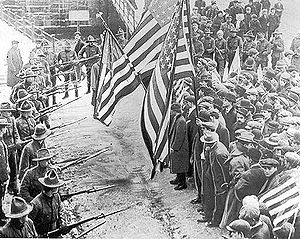
Back Textilní stávka v Lawrence Czech اعتصاب نساجی لارنس ۱۹۱۲ Persian Grève du textile à Lawrence French שביתת הטקסטיל של לורנס HE 로렌스 섬유 파업 Korean
| 1912 Lawrence textile strike | |||
|---|---|---|---|
 Massachusetts militiamen with fixed bayonets surround a group of strikers | |||
| Date | January 11 – March 14, 1912[1] | ||
| Location | |||
| Goals | 54-hour week, 15% increase in wages, double pay for overtime work, and no bias towards striking workers | ||
| Methods | Strikes, protests, demonstrations | ||
| Parties | |||
| |||
| Lead figures | |||
Joseph Ettor; | |||
| Number | |||
| |||
| Casualties and losses | |||
| |||
The Lawrence Textile Strike, also known as the Bread and Roses Strike, was a strike of immigrant workers in Lawrence, Massachusetts, in 1912 led by the Industrial Workers of the World (IWW). Prompted by a two-hour pay cut corresponding to a new law shortening the workweek for women, the strike spread rapidly through the town, growing to more than twenty thousand workers and involving nearly every mill in Lawrence.[3] On January 1, 1912, the Massachusetts government enforced a law that cut mill workers' hours in a single work week from 56 hours, to 54 hours. Ten days later, they found out that pay had been reduced along with the cut in hours.[4]
The strike united workers from more than 51 different nationalities.[5] A large portion of the striking workers, including many of the leaders of the strike, were Italian immigrants. Carried on throughout a brutally cold winter, the strike lasted more than two months, from January to March, defying the assumptions of conservative trade unions within the American Federation of Labor (AFL) that immigrant, largely female and ethnically divided workers could not be organized. In late January, when a striker, Anna LoPizzo, was killed by police during a protest, IWW organizers Joseph Ettor and Arturo Giovannitti were framed and arrested on charges of being accessories to the murder.[6] IWW leaders Bill Haywood and Elizabeth Gurley Flynn came to Lawrence to run the strike. Together they masterminded its signature move, sending hundreds of the strikers' hungry children to sympathetic families in New York, New Jersey, and Vermont. The move drew widespread sympathy, especially after police stopped a further exodus, leading to violence at the Lawrence train station.[6] Congressional hearings followed, resulting in exposure of shocking conditions in the Lawrence mills and calls for investigation of the "wool trust." Mill owners soon decided to settle the strike, giving workers in Lawrence and throughout New England raises of up to 20 percent. Within a year, however, the IWW had largely collapsed in Lawrence.[6]
The Lawrence strike is often referred to as the "Bread and Roses" strike. It has also been called the "strike for three loaves".[7] The phrase "bread and roses" actually preceded the strike, appearing in a poem by James Oppenheim published in The American Magazine in December 1911.[8] A 1915 labor anthology, The Cry for Justice: An Anthology of the Literature of Social Protest by Upton Sinclair, attributed the phrase to the Lawrence strike, and the association stuck.[9][10] A popular rallying cry from the poem was interwoven with the memory of the strike: "Hearts starve as well as bodies; give us bread, but give us roses!"[4]
- ^ United States. Bureau of Labor; Neill, Charles Patrick (1912). Report on strike of textile workers in Lawrence, Mass., in 1912. Cornell University Library. Washington, Govt. print. off. p. 9.
- ^ Cozzarelli, Tatiana (January 11, 2019). "'It is Bread We Fight For, But We Fight for Roses Too': The Lawrence Textile Strike". Left Voice. Archived from the original on July 22, 2023. Retrieved July 22, 2023.
- ^ Sibley, Frank P. (March 17, 1912). "Lawrence's Great Strike Reviewed: Cost $3,000,000, Lasted Nine Weeks – 27,000 Workers Out". The Boston Daily Globe. ProQuest 501968425. Archived from the original on November 14, 2017. Retrieved July 5, 2017.
Tomorrow morning ends officially the strike of the textile operatives at Lawrence, in nearly all the mills.
- ^ a b "Lawrence, MA factory workers strike "for Bread and Roses," U.S. 1912". Archived from the original on January 8, 2019. Retrieved November 13, 2017.
- ^ Watson, Bruce (2005). Bread & Roses: Mills, Migrants, and the Struggle for the American Dream. New York: Penguin Group. p. 8.
- ^ a b c Cite error: The named reference
weirwas invoked but never defined (see the help page). - ^ Milkman, Ruth (2013). Women, Work, and Protest: A Century of U.S. Women's Labor History. Routledge. p. 67. ISBN 9781136247682.
- ^ Oppenheim, James (December 1911). American Magazine. Colver Publishing House. p. 214.
- ^ Sinclair, Upton (1915). The Cry for Justice: An Anthology of the Literature of Social Protest ... Sinclair. p. 247.
- ^ Zwick, Jim (2003). "Behind the Song: Bread and Roses". Sing Out! The Folk Song Magazine. 46: 92–93. ISSN 0037-5624. OCLC 474160863.